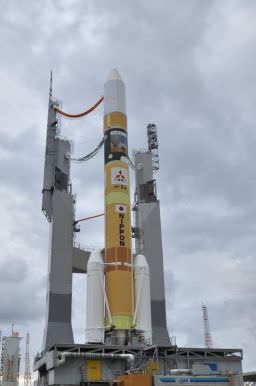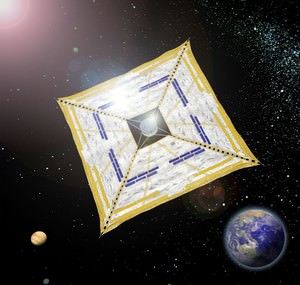Bad weather postponed a scheduled multi-mission launch of an H-IIA rocket from Japan early Tuesday, which includes the first Japanese probe to Venus and an experimental solar sail. The next launch attempt for the “Akatsuki” Venus Climate Orbiter and the solar sail called IKAROS will be Thursday, May 20, at 21:58 UTC (May 20 at 5:58 EDT) – which is May 21 at 6:58 in Japan. Akatsuki is Japan’s first mission to Venus, and it will work closely with the ESA’s Venus Express, already at Venus. Also called Planet C, the box-shaped orbiter should arrive at Venus in December and observe the planet from an elliptical orbit, from a distance of between 300 and 80,000 kilometers (186 to 49,600 miles), looking for — among other things — signs of lightning and active volcanoes.
[/caption]
Another payload is the solar sail, or “space yacht” IKAROS (Interplanetary Kite-craft Accelerated by Radiation of the Sun). This 320kg, 1.8m-wide, disc-shaped spacecraft will deploy an ultra-thin, ultra-light, 14 meter sail that will propel the structure from the radiation pressure from sunlight hitting it.
“The purpose of IKAROS is to demonstrate the technology of the Solar Power Sail,” said Osamu Mori, project leader of IKAROS. “Simply put, the solar sail is a ‘space yacht.’ A yacht moves forward on water, pushed by wind captured in its sails. A solar sail is propelled by sunlight instead of wind, so it’s a dream spaceship – it doesn’t require an engine or fuel. Part of IKAROS’s sail is covered by a solar cell made of an ultra-thin film, which generates electricity from sunlight.”
So far, solar sails have only been tested, but never flown successfully. It is hoped IKAROS will be the world’s first solar-powered sail, and that the structure will sail towards Venus, following Akatsuki.
The experimental sail is thinner than a human hair, is also equipped with thin-film solar cells to generate electricity, creating what JAXA calls “a hybrid technology of electricity and pressure.”
To control the path of IKAROS, engineers will change the angle at which sunlight particles bounce off the sail.

If you are a member of The Planetary Society, your name will be heading to Venus on both Akatsuki and IKAROS. The Planetary Society, a long-time proponent of solar sail technology, and Japan’s space exploration center, JSPEC/JAXA, have an agreement to collaborate and cooperate on public outreach and on technical information and results from IKAROS, which will help TPS plan for its upcoming launch of its own solar sail vehicle, LightSail-1, which they hope to launch in early 2011.
Emily Lakdawalla at the Planetary Blog has more details about the two missions and TPS’s involvement.
The H-IIA will also carry four other small satellites, developed by Japanese universities and other institutions. They include:
The 2-pound Negai CubeSat, developed by Soka University of Japan. Negai will test an information processing system during a three-week mission.
The WASEDA-SAT2, developed by Waseda University. The 2.6-pound spacecraft will conduct technology experiments in orbit.
The 3.3-pound KSAT spacecraft developed by Kagoshima University will conduct Earth observation experiments.
The 46-pound UNITEC-1 satellite from the Japanese University Space Engineering Consortium will test computer technologies and broadcast radio waves from deep space for decoding by amateur radio operators.
The rocket will launch from Japan’s Tanegashima Space Center in southern Japan.
For more information on IKAROS, read this interview with the project leader, Osamu Mori











